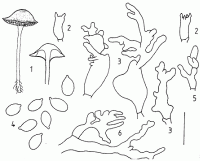|
 Mycena austroavenacea Mycena austroavenacea
BiostatusPresent in region - Indigenous. Non endemic
Images (click to enlarge)
Caption: Fig.3 M. austroavenacea. 1. basidiomes. 2. basidia. 3. cheilocystidia. 4. basidiospores. 5. pleurocystidium. 6. pileipellis elements. |
Article: Segedin, B.P. (1991). Studies in the Agaricales of New Zealand: some Mycena species in sections Longisetae, Polyadelpha, Rubromarginatae, Galactopoda, Lactipedes, and Calodontes. New Zealand Journal of Botany 29(1): 43-62 (http://www.rsnz.org/publish/abstracts.php).
Description: Pileus 10-20 mm,
convex to broadly companulate when older, vinaceous russet (10D5 K&W) to
dark vinaceous brown in the centre, dry, downy under lens, rugulose, striate
at the margin for a short distance, very dark vinaceous when dried. Lamellae
very broadly adnate to slightly decurrent, pinkish fawn with a very conspicuous
red margin, in 4 series, thin, well spaced, very broad (up to 5 mm). Stipe 15-40
X 2 mm, dark vinaceous red-brown, like the centre spot of the pileus, smooth,
even, slightly flawing at the base which may be slightly fibrillose. No latex
when broken. Flesh thin under the lamellae but solid above the stipe. Odour
and taste not noticeable.
Spore print white.
Spores 5-7 X 3-4 (5.7 X 3.3) µm. Q = 1.7, ellipsoid to elongate, variable in
size, larger probably from 2-spored basidia, hyaline, thin-walled, weakly amyloid.
Basidia 15 X 6 µm., 2- and 4-spored. Cheilocystidia 40-80 X 9-15 µm., forming
abroad, sterile edge to the lamella, basically clavate, hyaline or with red
(brown in KOH) sap, producing a complicated system of diverticulate apical blanches
all with red sap. Pleurocystidia rather infrequent, much smaller versions of
the cheilocystidia, faintly yellow-brown in KOH. Trama of parallel, inflated
hyphae 3-15 um diam., colourless, vinaceous brown in Melzer's. Sub hymenium
narrow, of narrow hyphae. Context of inflated cells like the trama with a few
fine conducting hyphae and some clusters of cells with yellow-brown contents.
Pileipellis of repent inflated hyphae with red (brown) sap, producing many branched
protuberances rather like the cheilocystidia, with lighter coloured sap. Subpellis
of large, inflated cells with brown sap, up to 30µm. diam. Stipe of long, narrow
hyphae, with yellow-brown sap, no conducting hyphae present. Caulocystidia none.
Clamp connections present
Habitat: HABITAT: On litter in podocarp dicotyledonous forest
Notes: This appears to
be same fungus originally described by Singer (1969) from Argentina under Nothofagus
dombeyi (Mirbel) Oersted and recorded by Horak (1979) in Tierra del Fuego
also growing under Nothofagus. In New Zealand it is likely to be growing
under Leptospermum scoparium J. R. et G. Forst. or Kunzea ericoides,
(A. Rich.) J. Thompson. Hongo (1977) described a new species from Japan, which
he named M. neoavenacea. This has ascending lamellae, much more distinctive
pleurocystidia and larger spores than the New Zealand fungus.
|